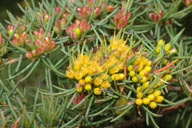In Flower This Week
A news sheet prepared by a Gardens' volunteer.
Numbers before each plant refer to temporary IFTW labels in the gardens.
Numbers in square brackets [ ] refer to garden bed Sections. Plants in flower are in bold type.
View past issues of 'In Flower This Week'.
3 September 2014
Homoranthus flavescens click for larger image |
A short walk from the VIC will find many spring-flowering plants in bloom throughout the Gardens at this time.
- Acacia gordonii [Section 174], on the right, is a small neat bush with bright gold balls of flowers. In the wild this plant is restricted to an area north-west of Sydney and is considered endangered.
- Chorizema cordatum [Section 174] or Heart-leaved Flame Pea, on the right in a pot, is a showy weeping shrub with vivid red flowers and bright green prickly foliage. It grows naturally in the moist southwestern parts of Western Australia.
- Acacia myrtifolia [Section 174], further along on your right, is an interesting and unusual wattle that has vibrant red new growth and stems with green elliptical phyllodes and cream balls of flowers. It is often called the Red-stemmed Wattle or Myrtle Wattle. It is found in all six Australian states.
- As you walk across the bridge notice on your left a large tree, Acacia melanoxylon [Section 305], with many pale yellow balls of flowers and “eucalypt-like” phyllodes. This tree is widespread in eastern Australia, extending from the Atherton Tableland in northern Queensland, south through to South Australia and into Tasmania.
- As you walk past the café look to your left to see Daviesia horrida [Section 245] with extremely prickly grey foliage showing off bright orange/red pea flowers. This shrub is endemic to south-west Western Australia.
- Also on your left is Grevillea sericea subsp. sericea [Section 244], an open, airy bush with light green foliage and white spider flowers. This plant occurs naturally west of Sydney.
- In the Ellis Rowan Garden on your left [Section 131] is the mallee gum, Eucalyptus gregsoniana, with a grey trunk and white fluffy flowers. The Wolgan Snow Gum or Mallee Snow Gum, as it is commonly known, is found in the highlands of New South Wales.
- On your right is Alyogyne huegelii ‘West Coast Gem’ [Section 240], with clear purple “hibiscus” flowers and coarse divided foliage.
- Also on the right is Phebalium squamulosum subsp. lineare [Section 240], a medium-sized bush with fine needle-like foliage and pale yellow flowers with prominent stamens.
- Further on your left is Micromyrtus ciliata [Section 131] with graceful arching sprays of very fine close foliage and masses of tiny white flowers opening from pink buds.
- Acacia alata var. biglandulosa [Section 240], or Winged Wattle, on the right, has flattened phyllodes and masses of white fluffy balls of flowers. It is native to Western Australia.
- Continue straight ahead to see on your right‑hand side Homoranthus flavescens [Section 143], a neat bush with needle-like leaves and bright acid yellow flowers on top of the foliage.
- Turn right and on your right is Grevillea rosmarinifolia [Section 180], with prickly grey-green needle foliage and bright pinkish-red flowers.
- Also on your right is Zieria formosa [Section 180], with masses of dusty pink flowers with darker centres. Both surfaces of the leaves are covered in a dense, velvety layer of hair, giving the foliage a silvery appearance. This plant is endangered in the wild.
- On the right is Banksia ericifolia var. ericifolia [Section 306] with bright orange flower heads and green “heath-like” foliage. Heath-leaved Banksia is one of the best known members of the genus, having been in widespread cultivation for many years.
Rosalind Walcott
![Director of National Parks [logo]](../../../../images/dnp_90px.gif)







